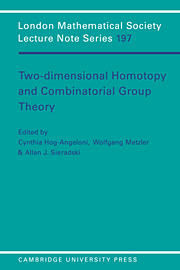Book contents
- Frontmatter
- Contents
- Editors' Preface
- Addresses of Authors
- I Geometric Aspects of Two-Dimensional Complexes
- II Algebraic Topology for Two Dimensional Complexes
- III Homotopy and Homology Classification of 2-Complexes
- IV Crossed Modules and Π2 Homotopy Modules
- V Calculating Generators of Π2
- VI Applications of Diagrams to Decision Problems
- VII Fox Ideals, N-Torsion and Applications to Groups and 3-Manifolds
- VIII (Singular) 3-Manifolds
- IX Cancellation Results for 2-Complexes and 4-Manifolds and Some Applications
- X J. H. C. Whitehead's Asphericity Question
- XI Zeeman's Collapsing Conjecture
- XII The Andrews-Curtis Conjecture and its Generalizations
- Bibliography
- Index
XI - Zeeman's Collapsing Conjecture
Published online by Cambridge University Press: 20 January 2010
- Frontmatter
- Contents
- Editors' Preface
- Addresses of Authors
- I Geometric Aspects of Two-Dimensional Complexes
- II Algebraic Topology for Two Dimensional Complexes
- III Homotopy and Homology Classification of 2-Complexes
- IV Crossed Modules and Π2 Homotopy Modules
- V Calculating Generators of Π2
- VI Applications of Diagrams to Decision Problems
- VII Fox Ideals, N-Torsion and Applications to Groups and 3-Manifolds
- VIII (Singular) 3-Manifolds
- IX Cancellation Results for 2-Complexes and 4-Manifolds and Some Applications
- X J. H. C. Whitehead's Asphericity Question
- XI Zeeman's Collapsing Conjecture
- XII The Andrews-Curtis Conjecture and its Generalizations
- Bibliography
- Index
Summary
Introduction
The subject of this chapter is the rather audacious conjecture put forward in 1964 by E. C. Zeeman.
Zeeman's Conjecture (Z)If P2is a contractible 2-dimensional polyhedron, then P2is 1-collapsible, that is, P2 × I collapses to a point.
As already pointed out in Chapter I, §4.2, (Z) implies both the Poincaré conjecture (P) and the Andrews-Curtis conjecture (AC). It is an affirmation of the subtlety of low-dimensional topology that these old basic conjectures are still unsolved, despite strenuous efforts of generations of topologists. The attempts to solve (Z) have led mathematicians to discover novel ideas and powerful methods in low-dimensional topology, and to a deeper understanding of the strange and mysterious world of 2-dimensional complexes.
Although there are many candidates for counterexamples, (Z) has not been refuted (if it is false!) because, for the present, we have no methods of detecting non-collapsibility for contractible 3-dimensional polyhedra of the form P2 × I. As a result, the main achievements in investigation of (Z) consist in
proving it for different special types of P2;
proving of weakened and disproving of strengthened versions of (Z).
The first contributions to (1) were made by P. Dierker, W. B. R. Lickorish, D. Gillman [Di68, Li70, Gi86] and may be called collapsing by adding a cell.
- Type
- Chapter
- Information
- Two-Dimensional Homotopy and Combinatorial Group Theory , pp. 335 - 364Publisher: Cambridge University PressPrint publication year: 1993
- 3
- Cited by

